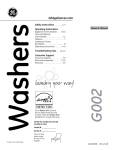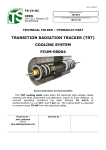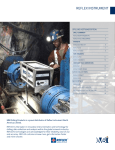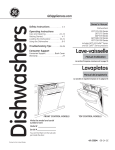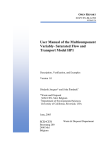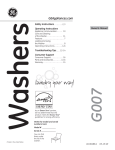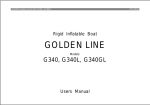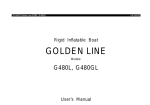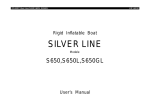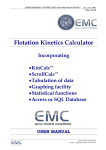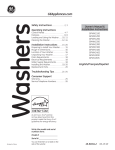Download USER MANUAL
Transcript
INTEGRATED GEOMETALLURGICAL SIMULATOR USER MANUAL SGS Canada Inc. 1140 Sheppard Ave West Unit # 6, Toronto, Ontario, Canada M3K 2A2 Tel: (416) 633-9400 Fax: (416) 633-2695 www.met.sgs.com www.ca.sgs.com Member of the SGS Group (SGS SA) IGS User Manual Table of Contents Getting Started ........................................................................................................................................1 1. Introduction.....................................................................................................................................1 2. System Requirements ....................................................................................................................1 3. Installation ......................................................................................................................................1 4. Uninstallation ..................................................................................................................................1 Operating Guide......................................................................................................................................2 5. Main Window Overview ..................................................................................................................2 6. Project File Management................................................................................................................5 6.1. Creating New Project.............................................................................................................6 6.2. Opening Existing Project .......................................................................................................6 6.3. Save Project ..........................................................................................................................7 6.4. Save Project as New project..................................................................................................7 6.5. Close Project .........................................................................................................................8 7. Flowsheet Management .................................................................................................................9 7.1. Creating a New Flowsheet.....................................................................................................9 7.2. Open Flowsheet.....................................................................................................................9 7.3. Save Flowsheet ...................................................................................................................10 7.4. Import Flowsheet .................................................................................................................12 7.5. Export Flowsheet .................................................................................................................12 7.6. Export Flowsheet to Image ..................................................................................................13 7.7. Modify Flowsheets ...............................................................................................................14 8. Data Management ........................................................................................................................16 8.1. Select Dataset .....................................................................................................................16 8.2. Import Data Sets..................................................................................................................17 8.3. View Data Sets ....................................................................................................................18 9. Grinding Simulation......................................................................................................................18 9.1. Select Dataset .....................................................................................................................18 9.2. Configure Grind Circuit ........................................................................................................19 9.3. Simulation and Reporting ....................................................................................................19 10. Flotation Simulation ......................................................................................................................21 10.1. Select Dataset .....................................................................................................................21 10.2. Configure Flotation Circuit ...................................................................................................21 10.2.1. Creating Flowsheet ..................................................................................................21 10.2.2. Units Configuration...................................................................................................23 10.2.3. Stage Setup..............................................................................................................24 10.3. Simulation and Reporting ....................................................................................................26 Appendix A – Flotation Model SGS Minerals Services i IGS User Manual 1 Getting Started 1. INTRODUCTION Integrated Geometallurgical Simulator (IGS) is a comminution and flotation simulation tool for production forecasting and circuit design. The simulation parameters are extracted from standard tests, Minnovex Flotation Test (MFT) for flotation and SAG Power Index (SPI) for comminution. 2. SYSTEM REQUIREMENTS Operating System: Windows XP Service pack 3 Windows Vista Service Pack 1 Windows 7 Software: Microsoft .NET Framework 4.0 Microsoft SQL Server 3.5 SP2 Compact Edition 3. INSTALLATION Execute the installer file provided in the SGS USB key and follow the instructions. All required software, Microsoft .NET Framework 4.0 and Microsoft SQL Server Compact Database, will be downloaded by the installer. Note: Administrative privileges are required to install Microsoft .NET Framework 4.0 and Microsoft SQL Server Compact Edition. If you have not received a SGS USB key, the install file can be downloaded from http://www.met.sgs.com. Place mouse over Applications and select Integrated Geometallurgical Simulator. Click on the download link and fill out the registration form. 4. UNINSTALLATION To uninstall IGS, open [Control Panel] via the start menu under settings. Double click on [Add or Remove Programs]. Scroll down and select IGS. Click uninstall and follow the instructions. SGS Minerals Services 2 IGS User Manual Operating Guide 5. MAIN WINDOW OVERVIEW Double click on the IGS icon will start the program and the following main window is displayed on the screen. Menu bar options Status bar: Displays Dataset name, flowsheet name, and simulation status The flotation main window (default) will appear after creating a new IGS project. Simluation type tab Flotation circuit construction frame Stage reporting frame Flotation unit property frame Selected dataset name Selected flowsheet name SGS Minerals Services IGS User Manual Clicking on the Grinding tab will change to the grinding main window interface. The tabs will be automatically selected based on the active dataset. The flotation tab is selected when the active dataset contains both grinding and flotation block data. As default, the flotation tab will be automatically selected when no active dataset is selected. SGS Minerals Services 3 IGS User Manual Menu Bar Options: • File: New: Create new project Open: Open existing project Save: Save project Save As: Save project as a new project file Close: Close the project Exit: Exit IGS program. • Edit: Undo: Undo last action Redo: Redo previous action Delete: Delete selection Cut: Cut selection to clipboard Copy: Copy selection to clipboard Paste: Paste clipboard to cursor • View: Zoom in: Zoom In by 25% Zoom out: Zoom Out by 25% Reset: Reset zoom to 100% • Flowsheet: New Flowsheet: Create a new flowsheet Open Flowsheet: Open an existing flowsheet Save Flowsheet: Save the flowsheet Import Flowsheet: Import a flowsheet from file Export Flowsheet: Export the flowsheet to file Generate Flowsheet to Image: Export flowsheet to picture (PNG format) Modify Flowsheets: Rename and delete saved flowsheets • Data: Import Data: Import dataset from file Modify Data: Edit dataset name and description and delete datasets Select Data: Select dataset for simulation • Grinding: Configure: Configure grinding circuit inputs Simulate: Simulate grinding circuit • Flotation: Simulate: Simulate the flotation circuit Order Connections: Set stream reporting order • Help: About: Software information Status Bar • Dataset: Display selected dataset name • Simulation status Message display when simulation is complete or failed SGS Minerals Services 4 IGS User Manual 5 6. PROJECT FILE MANAGEMENT The IGS project file is a database containing multiple flowsheets and datasets. The database structure is show below. The flowsheets are constructed and configured by the user while the datasets are provided by SGS and are vital for simulation. There are two sub categories of datasets, flotation and comminution feed. The flotation feed contains mineral floatability data and the comminution feed contains ore’s grindability data. Appropriate datasets need to be loaded for the specific type of simulation. SGS Minerals Services IGS User Manual 6.1. CREATING NEW PROJECT 1) To create a new project file, select [File] on the menu bar and click [New]. 2) Enter a project name and select the destination folder. Then click [Save]. Destination folder Enter project name 6.2. OPENING EXISTING PROJECT 1) To open an existing project file, select [File] on the menu bar and click [Open]. 2) Navigate to the folder where the project file is located. 3) Select the project file and click [Open] or double clicking the project file. SGS Minerals Services 6 IGS User Manual 7 Destination folder Select project to open 6.3. SAVE PROJECT 1) To save the active project, select [File] on the menu bar and click [Save]. 6.4. SAVE PROJECT AS NEW PROJECT 1) To save the active project as a new IGS project file, select [File] on the menu bar and click [Save As]. 2) Navigate to the destination folder. Enter an IGS project name and click [Save]. SGS Minerals Services IGS User Manual 8 Destination folder Enter new IGS project name 6.5. CLOSE PROJECT 1) To close the active project, select [File] on the menu bar and click [Close]. 2) A save changes prompt will appear. Click [Yes] to save changes, [No] to discard changes, or [Cancel] to cancel the close action. Any changes made on the active flowsheet will be lost. SGS Minerals Services 9 IGS User Manual 7. FLOWSHEET MANAGEMENT A flowsheet is defined by a comminution circuit and a flotation circuit. The circuit to be simulated is dictated by the feed data. Multiple flowsheets can be saved in one project file and can be loaded as needed. 7.1. CREATING A NEW FLOWSHEET 1) Click on [Flowsheet] on the menu and select [New flowsheet] 2) A prompt window will appear asking to save the current flowsheet. 3) Click [Yes] to save the current active flowsheet. Click [No] to discard the current flowsheet. Note: The new flowsheet will not be saved when created. A save action is required to save the flowsheet to the project file. 7.2. OPEN FLOWSHEET Open a flowsheet saved in the project file. 1) Click on [Flowsheet] on the menu and select [Open Flowsheet] 2) Select the desired flowsheet to open and click [Open]. saved flowsheet and all its inputs will be loaded. SGS Minerals Services The 10 IGS User Manual Flowsheet name and author Selected flowsheet Flowsheet created and last modified time stamp Flowsheet description 3) A prompt window will appear asking to save the current flowsheet before openning. Click [Yes] to save, [No] to discard or [Cancel] to cancel the open flowsheet action. 7.3. SAVE FLOWSHEET Save the flowsheet into the project file. 1) Click on [Flowsheet] on the menu and select [Save Flowsheet]. 2) Enter a flowsheet name and description. click [Ok]. Then Both the comminution and flotation circuit flowsheet will be saved as well as the units’ inputs. SGS Minerals Services 11 IGS User Manual Note: A name must be given to save the flowsheet. If the field is empty, a red outline will appear around the name box. Error indicator SGS Minerals Services 12 IGS User Manual 7.4. IMPORT FLOWSHEET A flowsheet can be imported from a file (*.igsflsh). This will import the saved flowsheet and its inputs. Note: Flowsheet files do not contain datasets. 1) To import a flowsheet, select [Import] under [Flowsheet] on the menu bar. 2) Navigate to the destination folder and select the flowsheet file (*.igsflsh). Click [Open] Destination folder Select flowsheet file Note: Imported flowsheet will not be automatically saved into the project file. Refer to 7.3 to save the flowsheet into the project file. 7.5. EXPORT FLOWSHEET The active flowsheet can be exported to a file (*.igsflsh). parameters will be saved in the flowsheet file. Note: The datasets will not be exported. SGS Minerals Services The flowsheet diagram and the inputs IGS User Manual 13 1) To export flowsheet, select [Export] under [Flowsheet] on the menu bar. 2) Navigate to the destination folder and enter a name for the flowsheet. Press [Save]. Destination folder Enter flowsheet filename 7.6. EXPORT FLOWSHEET TO IMAGE The active flowsheet can be exported for reporting. This option will save the active flowsheet as a portable network graphics file (*.png). 1) Click on [Flowsheet] on the menu and select [Generate Image]. 2) Navigate to the destination folder and enter a filename. Click [Save]. SGS Minerals Services IGS User Manual 14 Destination folder Enter flowsheet filename 7.7. MODIFY FLOWSHEETS Each flowsheet is assigned a name and description upon saving. The flowsheet name and description can be modified through the [Manage Flowsheets] window. Flowsheets can also be deleted from the same window. 1) To open the flowsheet management window, click on [Flowsheet] on the menu and select [Modify]. 2) To delete a flowsheet, click the [Delete] button associated to the flowsheet. Click [Yes] on the confirmation pop-up to delete. SGS Minerals Services IGS User Manual 15 Edit flowsheet name and description Delete flowsheet permanently 1) To modify the flowsheet name and description, click on [Edit] associated to the flowsheet. The flowsheet name and description will become editable. Flowsheet name edit box Flowsheet description edit box 2) Click [Save] to save the changes. Press [Cancel] to discard the changes. 3) Press [Close] to exit the flowsheet management. SGS Minerals Services IGS User Manual 16 8. DATA MANAGEMENT The dataset files (*.igsdata) are vital for simulation and are provided by SGS. It contains all the mineral floatability and ore grindability information. 8.1. SELECT DATASET A dataset containing the appropriate feed must be selected to run a simulation. 1) To select the appropriate feed information or use another change the dataset for simulation, select [Data] and select [Select]. 2) Click on the dataset to be used for the simulation and click [Select]. To cancel the selection, click [Cancel]. The selected dataset’s name will appear in the status bar. SGS Minerals Services 17 IGS User Manual Selected dataset Flotation feed minerals Feed created and last modified times stamp General feed information 8.2. IMPORT DATA SETS 1) To import a dataset (*.igsdata), click on [Data] and select [Import]. 2) Navigate to the folder where the datasets are located, select the desired dataset file and click [Open]. Note: Importing additional dataset files will append to the list of datasets in the project file. SGS Minerals Services IGS User Manual 18 Destination folder Select dataset file 8.3. VIEW DATA SETS To view the block data of a dataset, select a data set and click [View]. A maximum of 100 blocks will be displayed. Click [Close] when finished. 9. GRINDING SIMULATION 9.1. SELECT DATASET Datasets containing grinding feed must be loaded for simulation. To select the dataset, follow the instructions outlined in 8.1. If a dataset containing both flotation and grinding feed is selected, only the grinding feed will be used in the simulation. SGS Minerals Services 19 IGS User Manual 9.2. CONFIGURE GRIND CIRCUIT 1) To configure the grinding circuit, click on [Grinding] tab on the left side of the main window. A graphical representation of a typical autogenous-ball mill circuit will appear. Invalid input 2) Fill out the input paramter form with appropriate values and click [Ok]. Note: Invalid inputs are indicated by a red outline around the input field. Place mouse over the input field will display an error tooltip. All input fields must be clear of errors in order to continue. Tips: Placing the mouse over the input field will display a tooltip with detail description of the input parameter. 9.3. SIMULATION AND REPORTING SGS Minerals Services IGS User Manual 20 With the appropriate dataset selected and the flowsheet configured, click on [Grinding] on the menu bar and select [Simulate]. Once the simulation is complete, a report window will appear. The first tab displays the result summary. The second to fifth tab display the cumulative distribution plots for feed, bond work index (BWi), SAG power index (SPI), circuit throughput, specific power, and transfer and product size. The limiting throughput plot is also included in the reporting window. The simulation results can be exported to excel (*xls, *.xlsx) or csv file. Click on [Export] on the report menu bar and select [Results]. Browse to the folder where the file will be saved, enter a filename, and SGS Minerals Services 21 IGS User Manual click [Save]. The simulation summary, detailed block output, the circuit configuration parameters, and the report plot’s x-y coordinates are reported. To save the simulation report, click on [Export] on the report menu bar and select [Save report]. Browse to the folder where the file will be saved, enter a filename, and click [Save]. To open an existing report, click on [File] on the main window menu bar and select [Open report]. Browse to the folder where the report file is located, open the file by selecting the file and click [Open] or by double-click on the file. 10. FLOTATION SIMULATIONS 10.1. SELECT DATASET Datasets containing flotation feed must be loaded for simulation. To select the dataset, follow the instructions outlined in 8.1. If a dataset containing both flotation and grinding feed is selected, only the matching blocks in both flotation and grinding feed will used in the simulation. The matching blocks in the grinding feed will be used to simulate the expected product size and throughput for each block. The results are then used as feed parameters for flotation simulation. Unmatching blocks are ignored and will not be simulated. 10.2. CONFIGURE FLOTATION CIRCUIT 10.2.1. Creating Flowsheet 1) Right click anywhere on the flowsheet construction frame to bring out a list of flotation unit icons. 2) Click on the desired unit will place the unit icon on the construction frame. Note: All flotation circuits must begin with a [Feed] unit and end with [Product] units. 3) Placing a [Feed] and [Mechanical Bank] units on the construction frame looks like the following (below). The added units are also listed in the stage reporting frame. SGS Minerals Services 22 IGS User Manual Error indicator List of units Input/output ports Note: Notice the red dot on the top left corner of the unit. This indicates that the unit is not properly configured. Right click on the unit and select [Show Errors] to display the error list associated with the unit. Note: The yellow dots indicate the unit’s input and output ports. Here, showing the mechanical bank’s input and output ports. These ports are used to connect the units together. 4) To move the units around the frame, place mouse over the center of the unit icon and the mouse cursor will change into . Click and drag the unit to the desired location in the construction frame. 5) To connect the units, mouse over the output ports (indicated by yellow dots). The mouse cursor will turn into . Click and drag to another unit’s input port (also indicated by yellow dots). If the unit SGS Minerals Services IGS User Manual cannot be connected at the cursor’s location, the cursor shape will turn into 23 . The mouse cursor will indicate that the input port can be connected with. 6) Repeat steps 2 to 7 until the flowsheet is constructed. 7) Save the flowsheet by clicking on [Flowsheet] on the menu bar and select [Save]. Enter a name and a description and click [Ok]. 10.2.2. Units Configuration Each unit needs to be manually configured. All newly created units will have typical values set. Select a unit on the construction frame stage or the stage view frame and the unit’s configuration inputs will appear in the unit property frame. SGS Minerals Services IGS User Manual Tip: 24 Placing the mouse over an input parameter will display the detailed description of the input parameter. Note: An invalid input will cause a red outline around the text box. A red dot will also be placed on the top right corner of the corresponding unit on the construction frame. 10.2.3. Stage Setup Several units can be grouped into one stage. The stage will be reported as a single unit with one feed and two output streams (concentrate and tails). This feature is useful for looking at the grade and recovery across several units as one cohesive unit. 1) To setup a stage, right click on the stage view frame and select [Add Stage]. 2) Click and drag the units to be reported in that stage. SGS Minerals Services IGS User Manual 25 3) To delete a stage, right click on the stage name and select delete. All units grouped under the deleted stage will be automatically moved out of the stage. 4) To name a stage, select the stage and enter a name for the stage in the [Name] field in the unit property frame. Repeat for all stages. Stage name SGS Minerals Services 26 IGS User Manual 5) The stage input(s) and output(s) need to be specified. Below the [Name] field, specify the streams that make up the stage’s feed, concentrate, and tails stream. Repeat for all stages. Feed stream components Concentrate stream components Tails stream components 6) Repeat steps 1 to 5 to create additional stages. 10.3. ORDER CONNECTIONS The stream reporting order can be changed. By default, IGS reports the stream in the order they are created. To change the stream order, click on [Flotation] on the menu bar and select [Order Connections]. SGS Minerals Services 27 IGS User Manual Each stream can be identified by the source unit’s output node or by the destination unit’s input node. By default, the stream is identified by the source unit’s output node. The stream name can be changed to the destination unit’s input node by click on [Toggle]. To move a stream, select the stream and click on one of the four movement buttons. Clicking on [Ascending] or [Descending] will automatically order the stream names alphabetically. Click [Ok] when finished or [Cancel] to discard the changes. 10.4. SIMULATION AND REPORTING With the appropriate dataset selected and the flowsheet constructed, click on [Flotation] on the menu bar and select [Simulate]. Once the simulation is complete, a report window with two tabs will appear. The first [Flotation] tab displays the flowsheet constructed by the user. The unit parameters are unchangeable in this window. At the bottom of the [Flotation] tab, each stream’s solid and volumetric flows are reported as well as the maximum solid and volumetric flow and maximum percent solids. SGS Minerals Services IGS User Manual 28 The second [Stage] tab reports the grade and recovery across the stage. Double clicking on a mechanical bank or flotation unit in the [Flotation tab] will report the grade and recovery across the unit in a new tab. SGS Minerals Services IGS User Manual SGS Minerals Services 29 IGS User Manual 30 Double clicking on other units (feed, product, junction, etc) or streams (lines connecting two units) will report the metal and mineral grade, flotation kinetics (kavg and Rmax), stream percent solids, and throughput (mass, water, and volume flow). For feed, junctions, and modifier units, the output stream is reported. To view the metals and minerals results of specific blocks, click on [Tools] and select [Select block(s)]. A pop-up window will appear with a list of blocks that were in the dataset. Click on the block(s) of interest and click [Select]. To select multiple blocks, hold down control (Ctrl) when clicking on the blocks. A maximum of 10 blocks can be selected at once. The simulation results can be exported to excel (2003, 2007, and 2010) or csv file. Click on [Export] on the report window’s menu bar and select [Results]. Browse to the folder where the file is to be saved, enter a filename, and click [Save]. The report file reports the mass/water recoveries, mineral and metal grade, and flotation kinetics of each mineral for each block in the dataset. The mechanical bank and flotation column performance are also reported. 11. FLOTATION BENCHMARK IGS can automatically benchmark plant survey data with MFT simulation results. This functionality is enabled by the dataset provided by SGS Canada. When a dataset with benchmark functionality enabled, the [Benchmark] option will appear under [Flotation] on the menu bar. SGS Minerals Services IGS User Manual 11.1. 31 SELECT DATASET AND FLOWSHEET CONSTRUCTION Datasets containing flotation feed and flotation survey must be loaded for simulation. To select the dataset, follow the instructions outlined in 8.1. Flotation Feed Data (Block Data) Flotation Survey Data (Plant Data) Construct the plant’s flowsheet by following the instructions outlined in 10.2. 11.2. BENCHMARK AND REPORTING With the appropriate dataset selected and the flowsheet constructed, click on [Flotation] on the menu bar and select [Benchmark]. If the [Benchmark] option is not available, please contact SGS Canada at [email protected] for more information. A dialog with objective function error will appear indicating the benchmarking progress. A report window will pop-up when the minimum error of the objective function is reached. The first two tabs plots the survey data versus simulated data on two different axes (linear and logarithmic). The remaining two tabs are standard flotation simulation report tabs. See section 10.4 for more information. SGS Minerals Services IGS User Manual 32 12. OPTIMIZATION IGS can automatically optimize the froth recovery to achieve the user’s desired grade and recovery ratio. This functionality is enabled by the dataset provided by SGS Canada. When a dataset with optimization functionality enabled, the [Optimize] option will appear under [Flotation] on the menu bar. 12.1. SELECT DATASET AND FLOWSHEET CONSTRUCTION Datasets containing flotation feed and an optimization target must be loaded for simulation. To select the dataset, follow the instructions outlined in 8.1. Construct the plant’s flowsheet by following the instructions outlined in 10.2. 12.2. OPTIMIZATION AND REPORTING With the appropriate dataset selected and the flowsheet constructed, click on [Flotation] on the menu bar and select [Optimize]. If the [Optimize] option is not available, please contact SGS Canada at [email protected] for more information. A dialog indicating the optimization progress will appear. Once complete the standard flotation report window will pop-up. See section 10.4 for more information. SGS Minerals Services IGS User Manual SGS Minerals Services 33 IGS User Manual APPENDIX A FLOTATION MODEL SGS Minerals Services 34 35 IGS User Manual 1.0 1.1 IGS: Flotation Model Flotation Simulation IGS is mathematical simulation software used to simulate a metallurgical operation to forecast the metallurgical production. It is also a powerful tool to monitor the operation. IGS employs a new mathematical model. FLEET used an iterative process where each unit is calculated until convergence before moving to the next unit. This method uses multiple nested loops which are very repetitive and time consuming. For flowsheets involving recycles, convergence will most likely not reached after the set maximum amount of iteration allowed. This obstacle was overcome with IGS by using a matrix of simultaneous equations to balance the entire circuit. Like the FLEET software, the flotation inputs for IGS are gathered from MFT tests. 1.2 System of Simultaneous Linear Equations IGS employs the system of linear equations (Ax = b) to solve the flowsheet, where A is a matrix representing the flowsheet configuration, x is the result vector (column matrix), and b the constraint vector. The constraint vector contains the solid and water going into the system. The matrix is solved for each mineral rate. The flowsheet, constructed by the user, can be represented using a matrix. The flowsheet configuration matrix is built as the user creates and joins the units together. For each newly created unit, the builder appends new row corresponding to the number of output port(s) and new column corresponding to the number of input port(s). For example, fresh feed unit has one output, mechanical bank cells and flotation column units have three ports (one input, two outputs), and junctions have multiple inputs and one output. The rows and columns that represent a specific unit are arranged in the order of input then output(s). For units with more than one output, the concentrate precedes the tails. Once the flowsheet matrix is setup, a number of systematic steps are taken to reduce the matrix by substitution and decomposed into an upper and lower triangular matrix. 1.3 Calculation Sequence The calculation sequence used by IGS is vastly different from FLEET because of the new mathematical model. The calculation sequence is depicted below. SGS Minerals Services 36 IGS User Manual 2.0 2.1 Flotation Kinetics Correction of Rmax and kavg A key advantage of the calculation process is that predictive modeling is performed at the plant particle size based on laboratory measurement of the flotation kinetics with a different particle size distribution. To achieve this, the first step in the calculation is adjusting, for each of the I minerals, the input maximum recovery and rate constant values from the SGS flotation test (MFT) particle size to the plant particle size using a correction factor calculated in the MFT parameter extraction process. A linear adjustment is made to the maximum recovery values: ( ) F I I I I Rmax, I = RmaxSlope, I × P80,MFT − P80, Plant + Rmax,I …(2.2.1) where F Rmax, I I max,I R I maxSlope, I R P80I ,MFT I 80, Plant P feed fractional maximum recovery of the Ith mineral input fractional maximum recovery of the Ith mineral from MFT input correction factor (linear slope) for Rmax for the Ith mineral input 80th percentile of the MFT test particle size distribution input 80th percentile of the plant particle size distribution An analogous linear correction is applied to the rate constant values: SGS Minerals Services 37 IGS User Manual ( ) F I I I I k avg , I = k avgSlope, I × P80, MFT − P80, Plant + k avg , I …(2.1.2) where F k avg ,I feed flotation rate constant of the Ith mineral k I avg , I k I avgSlope, I input flotation rate constant of the Ith mineral from MFT input correction factor (linear slope) for kavg for the Ith mineral I 80, MFT P input 80th percentile of the MFT test particle size distribution I 80, Plant P input 80th percentile of the plant particle size distribution For the remainder of the calculations, all references to values. 2.2 Determining the rate constants - kI,J 2.2.1 Description Rmax,I and k avg , I refer to these corrected feed For the modeling it is necessary to use fixed k values as the k distribution cannot be passed directly into the recovery calculation. Therefore, for each of the I = 1..N minerals, J = 1..M individual k values must be calculated for each distribution. This section describes the method of calculating the kI,J values. 2.2.2 Calculating kmax The kmax value is determined from the kavg and α (alpha) values for each of the I minerals by the following equation: k max,I = k avg ,I αI ( ) ⎛ F eα I − 2 + 1 ⎞ ⎟⎟ × ln⎜⎜ 1− D ⎝ ⎠ …(2.2.2.1) where Orivaldo takes F = D = 0.9999 kmax is the 99.99th percentile of the k distribution: this is an adequate approximation for our purposes. If kavg , F , I 2.2.3 is less or equal to 0.001, kmax=0 Calculating kmultiplier Once kmax is determined for the Ith mineral, this value is multiplied by a fixed, arbitrarily defined set of k ratios, defined here as kmultiplier, to define the edges (denoted kj where j = 1.. M) of the bins (denoted kJ where J = 1..M) that will be used to approximate the k distribution for each of the I minerals. The kmultiplier progression for all minerals is given by: SGS Minerals Services IGS User Manual 38 k multiplier for mineral I = 1..N 3.5 3 2.5 2 1.5 1 0.5 0 1 2 3 4 5 6 7 8 9 10 11 12 13 14 15 16 17 18 19 20 Bin [J] The values that exceed one are not used any further in the calculation and hence the progression is effectively given by: k multiplier for mineral I = 1..N 1.2 1 0.8 0.6 0.4 0.2 0 1 2 3 4 5 6 7 8 9 10 11 12 13 14 15 Bin [J] It is evident that this set of ratios is nearly linear, resulting in a slight bias towards a greater number of bins at low k values. The theoretical basis for a greater number of bins at low k is well founded and this distribution should be examined in terms of the number of bins required and the relative distribution of those bins (relative to kmax) to optimize the accuracy vs calculation speed. sValue = 2.2.4 1 1+ e −( normalisedBinEdgePosition−0.5 )sigmoidSteepness Calculating kI,J The first bin centre is taken to be zero. The remaining bin centres are simply determined as the average of two consecutive k values in the distribution yielding: k I , J =1 = 0 SGS Minerals Services IGS User Manual and k I , J = 2..M = 39 k I , j −1 + k I , j 2 …(2.2.4.1) Where the j values are taken to be the bin edge values and the J values are the bin centres used in the calculations that follow. The ratio of the kj and kJ values multiplied by alpha is determined, but this ratio is not used further in the calculations and should be removed from the code. 2.3 Determining the distribution of the feed in the flotation rate classes (kI,J) 2.3.1 Description The proportion of the Ith mineral in the feed falling in each of the J flotation rates must be determined to calculate the recovery and mass balance per flotation rate (kI,J). A cyclone partition curve equation is used to fit the floatability distribution in the parameter extraction and is therefore used in the simulation to apportion the mass to each of the bins. 2.3.2 Calculation of mass fractions per floatability class The equation to calculate the cumulative mass fraction in each floatability class is given by * Fcum, I , J = 1 − Rmax, I kI , J ⎛ ⎞ ⋅α ⎜ e kavg , I I − 1 ⎟ * ⎜ k ⎟ + Rmax, I ⎜ k I , J ⋅α I ⎟ ⎜ e avg , I + eα I − 2 ⎟ ⎝ ⎠ …(2.3.2.1) where Fcum,I , J cumulative mass fraction of mineral I apportioned to the Jth floatability class * max,I R fractional maximum recovery of the Ith mineral, corrected to the analysis P80 kI ,J flotation rate constant of the Jth floatability class for the Ith mineral kavg,I average flotation rate constant for the Ith mineral αI slope of the flotation rate constant cumulative distribution at the 50th percentile Note that this calculation is split into the calculation of EAUX by kI , J EAUX = e kavg , I ⋅α I …(2.3.2.2) which is substituted in to yield the above equation. The cumulative mass fraction appears to be given the variable name r. This calculation is performed for the fresh feed only. Subsequent cells use the values of TPH or are passed from the concentrate or tails of the preceding cell. 2.3.3 Calculation of feed mass flow per mineral per floatability class The relation M& cum, I , J = M& × FI × Fcum,I , J …(2.3.3.1) where SGS Minerals Services IGS User Manual M& cum, I , J cumulative mass flow of the Ith mineral in the Jth floatability class M& mass flow of the total feed to the unit FI mass fraction of the Ith mineral relative to the feed, also referred to as the assay value Fcum,I , J cumulative mass fraction of mineral I apportioned to the Jth floatability class follows from the definition. Also, M& I ,0 = M& cum, I ,0 …(2.3.3.2) and M& I , J = M& cum,I , J − M& cum,I , J −1 …(2.3.3.3) follow from the definition of the cumulative distribution. SGS Minerals Services 40 41 IGS User Manual 3.0 3.1 Mechanical Bank Recovery For each mechanical bank, the recovery of each mineral is calculated by balancing the amount of water and solids entering and exiting the system. The two compartment model by Savassi is used to calculate the solid flow and one of the three mechanisms is used to calculate the water recovery. The recovery of each mineral and water across each ‘stage’ or cell must be calculated for the mass balance. The two compartment model of Savassi is used to calculate the solids mass flow and one of three mechanisms are used to calculate the water recovery. 3.1.1 Residence Time IGS first calculates the residence time required using the following formula: τ= V Qw …(3.1.2.3) where τ residence time of the cell V Q& volume of the ‘stage’ where total V = N cellVcell volumetric flow of the feed to the cell, as opposed to the technically correct tails basis and M& Q& total = ∑ I , J + Q& w I , J SG I …(3.1.2.4) where SGI ,J specific gravity of the Ith mineral Q& w = M& w volumetric or mass flow rate of the water since SG = 1 3.1.2 Water Balance Once the residence time is established, the water is balanced. IGS gives the user three options to calculate water recovery: Percent solid of concentrate stream Fixed water flow per cell Fixed water flow per stage The first water balance option is the simplest of all three. The user specifies a desired percent solids target in the input sheet and the water recovery is calculated simply by dividing the mass flow by the specified percent solids and then multiplying by 1 – percent solids. The second method, fixed water flow per cell is calculated using a linear function of the froth recovery. The equation for this is simply: Rw = C1 + C2 R f …(3.1.3.1) SGS Minerals Services IGS User Manual 42 where Rw water recovery Rf froth recovery C1 the ‘constant’ parameter specified in the input sheet C2 the ‘linear’ parameter specified in the input sheet Note that the water recovery is a function of a constant parameter and froth recovery. Thus, the water recovery may change during the simulation runs. The water recovery is dependent of froth recovery, which is determined by solving the mass recovery until convergence. When the mass recovery converges, the water recovery iteration begins to solve for the water recovery. Therefore, by definition M& conc,I , J = RI , J ⋅ M& feed,I , J …(3.1.2.2) and M& conc,total = ∑ M& conc, I , J I ,J Then the water recovery is given by Rw = M& conc ,total M& w , feed ⎛ 1 ⎞ ⎜⎜ − 1⎟⎟ ⎝ φ conc ⎠ …(3.1.2.3) M& conc,total total mass flow rate M& w water flow rate φ conc concentrate solids fraction and on a ‘stage’ basis (1 / N ) Rw = 1 − (1 − Rw ) …(3.1.2.4) where N number of cells The final water recovery is the most complex of the three and requires the most iteration. The water flow is specified by stages, where multiple mechanical banks are grouped together. The water recovery is calculated, similarly to the 2nd method, for every cell and summed. The final equation for conversion of a cell recovery to a ‘stage’ recovery is under review and the derivation is as follows: By definition Rw = Q& w,conc M& w,conc = Q& w, feed M& w, feed given that SGw = 1 …(3.1.2.5) Per the above equation Rw = M& s ,conc M& w, feed ⎛ M& S ,conc + M& w,conc ⎞ ⎜ − 1⎟⎟ ⎜ & M s ,conc ⎝ ⎠ …(3.1.2.6) therefore SGS Minerals Services IGS User Manual M& s ,conc ⎛ M& s ,conc + M& w,conc − M& s ,conc ⎞ ⎜ ⎟ ⎟ M& w, feed ⎜⎝ M& s ,conc ⎠ ⎛ M& ⎞ M& Rw = s ,conc ⎜⎜ w,conc ⎟⎟ M& w, feed ⎝ M& s ,conc ⎠ …(3.1.2.8) 43 Rw = …(3.1.2.7) so Rw = M& w,conc M& w, feed 3.1.3 …(3.1.2.9) Volumetric recovery As shown above M& Q& total = ∑ I , J + Q& w I , J SG I …(3.1.2.5) And by definition M& I , J ,conc = RJ M& I , J , feed …(3.1.2.6) Then RJ M& I , J , feed Q& T ,conc = ∑ + Rw Q& w SG I I ,J …(3.1.2.7) and we can define recovery on a volumetric basis as RQ = 3.1.4 ∑ I ,J RJ M& I , J , feed + RwQ& w, feed SGI QT , feed …(3.1.2.8) Water recovery Water recovery is calculated by one of three mechanisms. The first, a water recovery specified in the input sheet, is the simplest of the three and this value is used directly in the recovery calculation. The second method is to use a linear function of the froth recovery to determine the water recovery. The equation for this form is simply Rw = C1 + C2 R f …(3.1.3.1) where Rw water recovery Rf froth recovery C1 the ‘constant’ parameter specified in the input sheet C2 the ‘linear’ parameter specified in the input sheet It is interesting to note that if Rw is a function of Rf and Rf is a function of an input parameter, Rw may change depending on simulation run inputs. SGS Minerals Services IGS User Manual 44 The concentrate percent solids calculation is performed iteratively in the sense that the water recovery is recalculated once per loop over all simulation units. Note that this does not mean that the water recovery – mass recovery relationship is solved within each unit for each outer loop iteration. Instead, the mass recovery is calculated once on the basis of the last mass recovery calculation. This is likely to contribute to a large number of loops required for convergence and instability in the model calculation. By definition M& conc,I , J = RI , J ⋅ M& feed,I , J …(3.1.2.2) and M& conc,total = ∑ M& conc, I , J I ,J Then the water recovery is given by Rw = M& conc ,total M& w , feed ⎛ 1 ⎞ ⎜⎜ − 1⎟⎟ ⎝ φ conc ⎠ …(3.1.2.3) M& conc,total total mass flow rate M& w water flow rate φ conc concentrate solids fraction and on a ‘stage’ basis (1 / N ) Rw = 1 − (1 − Rw ) …(3.1.2.4) where N number of cells The final equation for conversion of a cell recovery to a ‘stage’ recovery is under review. The derivation of the above is as follows: By definition Rw = Q& w,conc M& w,conc = Q& w, feed M& w, feed given that SGw = 1 …(3.1.2.5) Per the above equation Rw = M& s ,conc ⎛ M& S ,conc + M& w,conc ⎞ ⎜ − 1⎟⎟ M& w, feed ⎜⎝ M& s ,conc ⎠ …(3.1.2.6) therefore Rw = M& s ,conc M& w, feed M& Rw = s ,conc M& w, feed ⎛ M& s ,conc + M& w,conc − M& s ,conc ⎞ ⎜ ⎟ ⎜ ⎟ & M s ,conc ⎝ ⎠ ⎛ M& w,conc ⎞ ⎜ ⎟ ⎜ M& ⎟ ⎝ s ,conc ⎠ …(3.1.2.8) …(3.1.2.7) so Rw = M& w,conc M& w, feed …(3.1.2.9) SGS Minerals Services IGS User Manual 3.1.5 45 Overall Recovery Each of the three water flow options uses different formula to determine the water flow in the streams, which affects the overall recovery. Using the two compartment model by Savassi, the overall recovery is calculated by: FR ⋅ (1 − Rwat ) + ENT ⋅ Rwat k CZ ⋅* τ CZ ⋅ Ratt = * CZ * CZ FR (1+ k ⋅ τ ⋅ Ratt )⋅ (1 − Rwat ) + ENT ⋅ Rwat * Rovr …(3.1.2.1) In the terminology of this work, this is rephrased as RI , J = k I , J ⋅τ ⋅ R f ⋅ (1 − Rw ) + ENT ⋅ Rw (1 + k I , J ⋅τ ⋅ R f ) ⋅ (1 − Rw ) + ENT ⋅ Rw …(3.1.2.2) where RI ,J recovery of mineral I in the Jth floatability class kI ,J rate constant I, J Rf froth recovery defined in the cell input Rw water recovery, based on the last iteration ENT τ entrainment factor defined in the cell input residence time and τ= V Qw …(3.1.2.3) where τ residence time of the cell V Q& total volume of the ‘stage’ where V = N cellVcell volumetric flow of the feed to the cell, as opposed to the technically correct tails basis and M& Q& total = ∑ I , J + Q& w I , J SG I …(3.1.2.4) where SGI ,J specific gravity of the Ith mineral Q& w = M& w volumetric or mass flow rate of the water since SG = 1 Note that this is for the case of fixed water recovery or water recovery as a function of Rf. For fixed concentrate percent solids, and therefore water recovery as a function of solids recovery, the water recovery is calculated as per the following section. SGS Minerals Services IGS User Manual 3.2 Concentrate and tail mass flows By definition for all minerals and for water M& conc,I , J = RI , J ⋅ M& feed,I , J …(3.2.1) and the mass balance dictates that M& tail,I , J = M& feed,I , J − M& conc,I , J …(3.2.2) SGS Minerals Services 46 47 IGS User Manual 4.0 Flotation Column The column model differs from the mechanical cell model in that: It uses different collection zone recovery equations The residence time is that of the particles in the column Column flotation recovery may be limited by the carrying capacity of the bubbles or unit dimensions The flotation kinetics in a column efficiency are lower than in a mechanical and this is represented by a rate constant (kavg) modifier After the collection zone recovery is calculated, overall recovery is determined from the collection zone and froth recovery in a manner analogous to the mechanical cell model. 4.1 Definitions: Height and volume There are several dimension of a column cell is important and used in the column cell model to calculate the mass balance. The most important of all is the collection zone, which is where the particles adhere to the gas bubbles. H column H froth H column H froth Vcolumn V froth H airHoldup = Hcollectionε g Hcollection = Hcolumn − H froth − HbelowSpargers H collection H effective Vcollection Veffective H belowSp arg ers VbelowSp arg ers 4.2 Water balance 4.2.1 Balance of the concentrate water The concentrate water flow is calculated from the concentrate mass flow and the target concentrate solids fraction: SGS Minerals Services 48 IGS User Manual Qw,conc = M w,conc = 1 − ϕ conc ϕ conc The concentrate water Qw,conc channeling through the froth from the pulp M s ,conc Qw,conc, pulp derives from three sources: the wash water Qw,conc,channeling Qw,conc,ww , water from and (potentially) water from a negative bias, known as water : Qw,conc = Qw,conc, ww + Qw,conc, pulp + Qw,conc,channeling 4.2.2 Wash efficiency factor There is inefficiency in the froth referred to as channeling whereby a fraction of the feed water is not washed from the froth by the wash water. For the purposes of calculating recovery, this entrained material contributes to the water recovery (Rw) and entrainment. A wash efficiency factor (Ewash) is defined and the concentrate water flow from channeling is calculated relative to the concentrate water flow: (1 − E wash ) = Qw,conc ,channeling Qw,conc Rearranging Qw,conc,channeling= (1− Ewash)Qw,conc 4.2.3 Wash ratio and wash water We define a wash ratio as the ratio of the wash water addition to the concentrate water flow Wratio = Qww Qw,conc Case 1: Wash water calculated from specified wash ratio Qww = Qw,concWratio Case 2: Wash water rate specified as a constant C Qww = C 4.2.4 Bias and water from the pulp If there is not sufficient wash water to fully displace the pulp water (negative bias): Q < Qw,conc − Qw,conc,channeling If ( ww then ) Qw,conc, pulp = Qw,conc − Qww − Qw,conc,channeling Else if the wash water is sufficient to fully wash the froth (positive bias) elseif ( Qww ≥ Qw,conc − Qw,conc,channeling ) Qw,conc, pulp = 0 4.2.5 Water recovery and overall water recovery SGS Minerals Services 49 IGS User Manual For the purposes of calculating entrainment in the recovery equation, we define water recovery as the water in the concentrate that derives from the feed - therefore having the pulp composition: Qw,conc , pulp + Qw,conc ,channeling Rw = Qw, feed The overall water recovery is: Qw,conc Rw = Qw, feed + Qww However, in the overall water balance for the circuit we can treat the wash water as an additional feed stream (a junction before the column) so that it modifies the residence time correctly so in practice: Rw = Qw,conc Qw, feed 4.2.6 Reporting bias velocity For reporting, the bias velocity is required: J bias = Qww − Qw,conc Ac 4.3 Residence time 4.3.1 Effective slurry superficial velocity The vertical velocity of slurry in the column without air is given by: J sl , noHoldup = Qtails Acolumn Where J sl,noHoldup Superficial slurry velocity ignoring the effect of gas holdup: Qtails Tails volumetric flowrate including wash water Acolumn Cross sectional area of the column Then the true or effective slurry superficial velocity is given by: J sl ,eff = J sl ,noHoldup (1 − ε ) g 4.3.2 Slurry residence time Assuming the effective slurry residence time is used, the slurry residence time is given by: τ sl = H collection J sl ,eff …(5) Where: τ sl 4.3.3 Residence time of the slurry in the collection zone Mean particle density SGS Minerals Services 50 IGS User Manual The mean particle density is derived from the mass flow matrix in fractional form and the density of the particles / minerals M fractional , I , J = M I ,J ∑M I ,J Then ρ p = ∑ M fractional,I , J ρ I 4.3.4 Particle Reynolds Number Given an assumed value of the particle slip velocity, for example: U sp = 0.002 Particle slip velocity [m/s] Particle Reynolds number is calculated using the assumed slip velocity and recalculating relation: 1 Re p = U sp via the ρ lU sp d p ,50 μf Where: Re p Particle Reynolds number [dimensionless] ρl Density of the fluid [kg/m3] U sp Particle slip velocity [m/s] d p,50 50th percentile of the particle size distribution [µm] μf Viscosity of the liquid (water) [Pa.s or kg.s-1.m-1]; for water at 20C μ f = 0.001 Note that the existing column model corrects the Re for particle fraction, but this is incorrect. Also note that the units used in the existing column model are not SI. The units used are g, cm and s, which invalidates the value of Re, but these are used in the calculations due to constants calibrated for these units. Therefore: d p,50 = d p,50,input /10000 and units are: Re p Particle Reynolds number [dimensionless, incorrect] ρl Density of the fluid [tons/m3 = SG] U sp Particle slip velocity [cm/s], initially 0.2 cm/s d p,50 50th percentile of the particle size distribution [cm] μf 1 Viscosity of the liquid (water) [g.cm-1.s-1]; for water at 20C http://en.wikipedia.org/wiki/Reynolds_number SGS Minerals Services μ f = 0.01 51 IGS User Manual 4.3.5 Particle slip velocity 2 ⎛ dp ⎞ 2.7 g ⎜⎜ 6 ⎟⎟ (ρ p − ρ l )(1 − ϕ pulp ) 10 ⎠ = ⎝ 0.687 0.18μ f 1 + 0.15 Re p ( ) m 2 kg m m s2 m3 = = kg s m.s kg s 2 = m.s = m kg s s2 m.s U sp Where G = 981 cm/s …(2) 0.00018 0.009 0.00016 0.008 0.00014 0.007 0.00012 0.006 0.0001 0.005 0.00008 0.004 0.00006 0.003 0.00004 0.002 0.00002 0.001 0 Usp [m/s] Re Unit check: Re Usp 0 0 50 100 150 Dp50 Particle Reynolds number and slip velocity as a function of particle size after three iterations of substitution. Maximum relative error is 0.3% at 140µm 2 . 4.3.6 Particle residence time Particle superficial velocity is defined as: J p = J sl,eff + Usp Where 2 IGS Model Development Rev 23.xls SGS Minerals Services 52 IGS User Manual Jp Particle superficial velocity J sl,eff Effective slurry superficial velocity, accounting for gas holdup U sp Particle slip velocity relative to the slurry Then τp = H collection Jp 100 * 60 4.4 Recovery 4.4.1 Vessel dispersion number The vessel dispersion number is calculated by: Nd = 0.63Dcolumn SuperficialParticleVelocityH collection …(3) Given the vessel dispersion number and particle residence time, the Dobby-Finch equation is used to determine the a-parameter by: 4.4.2 ‘a’ parameter a = (1 + 4k J E ff τ p N d ) 0.5 Where a kJ a-parameter of the Dobby-Finch equation Flotation rate constant of the Jth rate class τp Particle residence time Nd Vessel dispersion number E ff Efficiency factor (k-multiplier) Then if 4.4.3 a > 1000 Nd ; a = 1000 N d …(7) Recovery in the collection zone The recovery in the collection zone can then be calculated from: R J ,att ,CZ ⎛ 1 ⎞ ⎡ ⎜ ⎟ ⎜ 2N ⎟ ⎢ 4ae ⎝ d ⎠ = 1− ⎢ a −a ⎢ 2 2 Nd 2 2 Nd − (1 − a ) e ⎣ (1 + a ) e ⎤ ⎥ ⎥ ⎥ ⎦ Where RJ ,att,CZ a Recovery of the Jth floatability class by attachment ‘a’ parameter of the Dobby-Finch equation SGS Minerals Services 53 IGS User Manual Nd 4.4.4 Vessel dispersion number Recovery Then the recovery of the Jth floatability class in the column is given by: RJ = RJ ,att ,CZ ⋅ R f ⋅ (1 − Rw ) + ENT ⋅ Rw (1 − RJ ,att ,CZ ) (1 − R J ,att ,CZ ⋅ (1 − R f )⋅ (1 − Rw )) + ENT ⋅ Rw (1 − RJ ,att ,CZ ) where RJ recovery of the Jth floatability class kJ rate constant of the Jth floatability class Rf froth recovery defined in the cell input Rw water recovery ENT entrainment factor SGS Minerals Services …(8) 54 IGS User Manual 5.0 Modifier Modifiers represent any unit that changes the floatability distribution of the feed to the product. This is equivalent to moving mass from one floatability/particle class or rate constant bin to another. Two distinct types of modifiers must be considered: Concentrate modifier Second float modifier The models of these two types of modifier are different since they represent significantly different physical processes. 5.1 Concentrate modifier The concentrate modifier typically takes rougher concentrate and represents a regrind and/or chemical change where the product has significantly lower floatability for the gangue mineral(s) and slightly reduced floatability for the valuable minerals. This type of modifier is typical of a copper concentrate regrind where the particles are further liberated or ‘polished’ in the regrind to remove attached gangue from the floatable particles, and/or the chemical conditions are changed to depress floatable gangue such as pyrite. In terms of the model, the modifier removes (subtracts) mass from some rate constant bins and adds it to others for each mineral, based on a per-mineral kavg and Rmax multiplier and constant value, in the form of a linear equation. Hence, for each mineral (I): Rmax,product,I = CR max,mod,I + M R max,mod,I Rmax,feed,I where Rmax,product Maximum recovery of the product from the modifier Rmax,feed Maximum recovery of the feed to the modifier CR max,mod Rmax constant value in the modifier M R max,mod Rmax multiplier value in the modifier and: kavg, product,I = Ckavg,mod,I + M kavg,mod,I kavg, feed,I where Rmax,product Maximum recovery of the product from the modifier Rmax,feed Maximum recovery of the feed to the modifier Ckavg,mod kavg constant value in the modifier M kavg,mod kavg multiplier value in the modifier SGS Minerals Services 55 IGS User Manual NOTE: In the initial design, the product rate constant values may not exceed the source values. Therefore: Ckavg,mod,I + M kavg,mod,I ≤ 1 If it is desirable that this constraint be lifted, the modifier and rate constant values will need to be redesigned to allow for higher than source rate constants. 5.1.1 Mass fraction adjustment for kavg of the product In order to calculate the mass fraction reallocation between bins it is necessary to determine the kavg of the modifier feed. Determining the 50th percentile of the floatable material in the feed By definition, the kavg is the 50th percentile (median) of the rate constant distribution, excluding the material in the 1st rate constant bin. Defining the nomenclature for this value: kavg = k50, J =2..N 50th percentile (median) of the mass in the J=2..N rate constant classes Consider D, the cumulative distribution of the mass fractions in the rate constant bins, excluding the first bin: D(k ) = ∫ X J = 2.. N In the (unlikely) case that there is a value D=0.5, the value. k50, J =2..N value is the corresponding rate constant Now, in the cumulative distribution there are (in general) discrete values of D that fall adjacent to the 50th percentile of the distribution at D=0.5. We will denote these and + 50 D for the value immediately below D = 0.5 for the value immediately above D = 0.5. The rate constant values that correspond to these points are denoted k 50, J =2.. N D50− k50− and k50+ respectively. Then, by linear interpolation: k 50+ − k 50− =k + + ( 0.5 − D50− ) − D50 − D50 − 50 Calculating the gamma parameter As defined above, for a given mineral (I): kavg,P = Ckavg,mod + Mkavg,modkavg,F Now we define an adjustment to the rate constant distribution, γ, that will be used to redistribute the mass between rate constant bins. Gamma is taken to be the ratio of the kavg values for the product and the feed. γ= k avg , P k avg , F Then γ = C kavg ,mod + M kavg ,mod k avg , F k avg , F = C kavg ,mod k avg , F + M kavg ,mod so γ = C kavg ,mod k 50, J = 2.. N , F + M kavg , mod SGS Minerals Services 56 IGS User Manual Applying the gamma adjustment to the mass fractions The rate constants for the entire simulation are fixed, so the rate constant values for the bins cannot be adjusted. Therefore, the mass fractions in each bin must be changed to duplicate the effect of the change in rate constant. For all J=2..N rate constants, the target product rate constant value is derived from gamma and the Jth rate constant value: kJ ,t arget = γ ⋅ kJ Consider the mass fraction redistribution for a given rate constant source value constant bins k − and k + exist that are adjacent to − kt arget . The mass fraction of the source bin is linearly + redistributed into k and k according to the relative distance to neighbour approach to the redistribution. Then for each source rate Mk,P = γMJ ,F k J . In general, two rate kt arget . This is also known as a nearest k J and its mass in the feed M J ,F and M k − , P + = (1 − γ )M J , F where: k + − k t arg et k+ − k− and M k + , P + = (1 − γ )M J , F where M k + ,P k t arg et − k − k+ −k− Mass fraction of the rate fraction bin adjacent to and above kt arget The deltas for each target bin are calculated for each source rate constant bin and summed. Once this is completed, there may be too much or too little material allocated to the zero flotation rate constant bin to satisfy the specified Rmax. The adjustment to get the appropriate Rmax is described below. 5.1.2 Mass fraction adjustment for Rmax of the product The material in the 1st rate constant bin is the material having a flotation rate of zero and is determined from: X1,P = 1− Rmax,P The adjustment to the rate constant distribution to achieve the correct Rmax after the modifier is performed after the redistribution of material by kavg. The mass fraction of material in each of the nonzero bins is adjusted on a mass weighted basis to adjust for the mass fraction of material in the 1st (Rmax) bin. So for each of the ΔX J = X J ,F ∑X J = 2.. N (X 1, F J = 2..N rate constant bins: − X 1, P ) J ,F where: ΔX J The change in the mass fraction of material in the Jth rate class between the feed and the product SGS Minerals Services IGS User Manual X J ,F The mass fraction of material in the Jth rate constant bin in the feed ∑ X J ,F J = 2.. N The sum of all mass fractions in the rate constant bins from bin 2 to the end of the array X1,F The mass fraction in rate bin one (the non-floatable material) in the feed X 1,P The mass fraction in rate bin one (the non-floatable material) in the product So X J ,F X J ,P = ∑X J = 2.. N (X 1, F − X 1, P ) + X J , F J ,F X J ,F (X − X ) + X (1 − X ) (1 − X ) =X (1 − X ) X J ,P = 1, F 1, P J ,F 1, F X J ,P 1, P J ,F 1, F For testing purposes: ∑ X J , F = X 1,P + J =1.. N ∑X ∑X J = 2.. N J = 2.. N J ,F (X 1, F − X 1, P ) + J ,F ∑X J = 2.. N J ,F where: ∑X J =1.. N J ,F The sum of all mass fractions in all bins, defined to be one And ∑X J = 2.. N J ,F 57 = 1 − X 1, F So 1 = X1,P + (X1,F − X1,P ) + (1 − X1,F ) which is true. SGS Minerals Services 58 IGS User Manual 5.2 6.0 Feed The feed is defined from the input values as follows: M& IF = M& I × CII …(5.1.1) where M& IF M& I C mass flow of the Ith mineral in the feed input mass flow of the total feed I I concentration or mass fraction of the Ith mineral in the feed, also referred to as the grade or assay F I Rmax, I = Rmax,I …(5.1.2) where F Rmax, I if fractional maximum recovery of the Ith mineral in the feed. If Rmax,I > 100, Rmax,I I max,I R Rmax,I < 0.001, Rmax,I =0; = 100. input fractional maximum recovery for the Ith mineral α IF = α II …(5.1.3) where α IF slope of the flotation rate constant cumulative distribution at the 50th percentile in the feed α II If α IF input slope of the flotation rate constant cumulative distribution at the 50th percentile. is less than 0.1 then α IF = 0.1, if α IF is greater than 20 then α flotation rate constant: see following section) and if RI , J = (EAUX I ,J (EAUX + e − 1) (α I − 2 ) )× R max, I α IF = 20. If 0 < F k avg ,I < 0.1 (the I I F k avg ,I is greater than 200 then α I = 200 + 100 − Rmax,I …(5.1.4) where RI , J th th recovery of the J floatability class for the I mineral. When RI , J equal to 30 then =100. SGS Minerals Services ⎛ k I , J + k I , J −1 ⎞ ⎜⎜ ⎟⎟ 2 ⎝ ⎠ ×α I k avg , F , I is greater or IGS User Manual M I × RI ,1 100 • M I ,1 = …(5.1.5) where • M I ,1 mass flow of the 1st floatability class for the Ith mineral • M I ,J = M I × (RI , J − RI , J −1 ) 100 …(5.1.6) where • M I ,J mass flow of the Jth floatability class for the Ith mineral ⎛ N C SG = ⎜⎜ ∑ I ⎝ I SGI ⎞ ⎟⎟ ⎠ −1 …(5.1.7) where SG SG I specific gravity of the pulp solid fraction specific gravity of the Ith mineral • F • M =M …(5.1.8) where • M mass flow total F CSolid = CSolid (5.1.9) where CSolid concentration solid, also referred to as percent solid F Solid C concentration solid in the feed • M × (100 − C Solid ) VW = C Solid • …(5.1.10) where • VW volumetric flow of water • • ⎡ (100 − CSolid ) 1 ⎤ + VP = M × ⎢ ⎥ C SG ⎦ Solid ⎣ …(5.1.11) SGS Minerals Services 59 IGS User Manual where • VP volumetric flow of pulp SGS Minerals Services 60 61 IGS User Manual 7.0 • Junction • S Z VP = ∑ V P S =1 …(5.2.1) where • S VP • volumetric flow of pulp in the feed streams S=1..Z • S Z VW = ∑ V W S =1 …(5.2.2) where • S VW volumetric flow of water in the feed streams S=1..Z • S Z • M I ,J = ∑ M I ,J S =1 …(5.2.3) where • S M I ,J • mass flow of the Jth floatability class for the Ith mineral in the feed streams S=1..Z M • M I = ∑ M I ,J J =1 • N …(5.2.5) • M = ∑MI I =1 …(5.2.6) • M C Solid = • • M +V W × 100 …(5.2.7) • CI = MI • M × 100 …(5.2.8) SGS Minerals Services …(5.2.4) IGS User Manual RI ,J • ⎛ Z S ⎜ ∑ R I , J × M IS = ⎜ ZS =1 • ⎜ S S ⎜ ∑ R I , 20 × M I ⎝ S =1 ⎞ ⎟ ⎟ × 100 ⎟ ⎟ ⎠ …(5.2.9) where RIS, J recovery of mineral I in the Jth floatability class in the feed streams S=1..Z • M IS mass flow of the Ith mineral in the feed streams S=1..Z • MI ∑ I =1 SGI N SG = • M ……(5.2.10) SGS Minerals Services 62 63 IGS User Manual 8.0 • F VP VP = NS • …(5.4.1) where NS the number of output streams • F VW NS • VW = …(5.4.2) • F M I ,J NS • M I ,J = …(5.4.3) • • MI = M IF NS …(5.4.4) • MF NS • M = …(5.4.5) • M CSolid = • • ×100 M +V W …(5.4.6) • CI = MI • × 100 M …(5.4.7) ⎛ F ⎜ RI , J × M IF =⎜ • ⎜ RF × M F I ⎝ I , 20 • RI , J N SG = ⎞ ⎟ ⎟ × 100 ⎟ ⎠ …(5.4.8) • MI ∑ SG I =1 I • M …(5.4.9) SGS Minerals Services Splitter 64 IGS User Manual 9.0 SG = SG F …(5.6.1) C I = C IF …(5.6.2) RI , J = RIF, J …(5.6.3) • F • M I ,J = M I ,J • M J =1 N …(5.6.4) • M I = ∑ M I ,J • Water adjuster …(5.6?.5) • M = ∑MI I =1 …(5.6.6) When the water addition option selected is “Change % Solids” then • F C Solid = M • F • F I × 100 − ΔC Solid M +V W …(5.6.7) where I ΔCSolid change in concentration solid defined in the input When the water addition option selected is “Target % Solids (Dilution only)” then I CSolid = CSolid …(5.6.8) where I CSolid target concentration solid defined in the input. If I F CSolid C Solid is less than then F CSolid = CSolid . When the water addition option selected is “Target % Solids (Dilute/Thicken)” then I CSolid = CSolid …(5.6.9) When the water addition option selected is “Water addition flowrate (m3/h)” and the number of loops is less or equal to 10 then SGS Minerals Services IGS User Manual • F C Solid = M ⎛ ⎞ M + ⎜⎜V W + V W × NumLoop × 0.01⎟⎟ ⎝ ⎠ • F • F • I × 100 …(5.6.10) where • I VW volumetric flow of water added defined in the input NumLoop the number of time the flowsheet has been recalculated When the water addition option selected is “Water addition flowrate (m3/h)” and the number of loops is greater than 10 then • F CSolid = • M × 100 ⎛•F •I ⎞ M + ⎜⎜V W + V W ⎟⎟ ⎝ ⎠ • F M × (100 − C Solid VW = C Solid • …(5.6.11) ) …(5.6.12) • • ⎡ (100 − CSolid ) 1 ⎤ VP = M × ⎢ + ⎥ C SG ⎦ Solid ⎣ …(5.6.13) SGS Minerals Services 65



































































